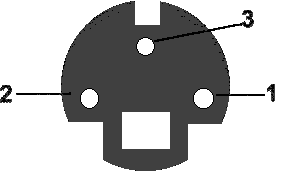|
Back to Know-How-Page
| VESA-3 miniDIN-3 connectors |
If you want STEREO right NOW don't count on boards with VESA DIN-3 connector! It's the standard of the future, not the present. The VESA-3 standard is new. There is almost no (consumer !) software, no games, no drivers, no (lcd-bios-)emulator, no patches, no information.ELSA uses the DIN-3 connector for their Revelator glasses, the required signal is generated by proprietary means on the data-pin of the VGA-port. ELSA's consumer boards don't have a DIN-3 connector, a special VGA-pass-through cable is used here.The miniDIN-3 connector existed before the VESA miniDIN-3 standard. It was used by StereoGraphics for their professional shutter-products (CrystalEyes & Z-Screen, NOT SimulEyes!). They proposed it to the VESA organization as a standard and it was accepted.The current version of the SimulEyes won't work even if the connector is refered to as SimulEyes port in the boards manual! Click here to see the how to build a cable which connects the old SimulEyes controller (!) to the DIN-3 port. Go to the homebrew page on how to connect a serial or parallel controller to the DIN-3.The new VESA DIN-3 connectors have different signaling specifications than the old 2.5/3.5 mm stereo jacks! Do not connect your "old" glasses to a VESA 3 connector directly or through a "dumb" adaptor. You'll need an "intelligent" adaptor. Consult the technology page for details.Scitech Display Doctor 6.0 contains the following univbe command line option: univbe on hwstereo
Looks like a software switch for the VESA3 glasses port, but I wasn't able to test it yet. Let's hope I'll find a company which provides me with evaluation samples. 
Current DIN-3 ready glasses:
- StereoGraphics CrystalEyes2 with ENT-controller
- StereoGraphics CrystalEyes Wired
- ELSA Revelator wired and wireless
- Nuvision 60GX and 60GX-NSR Please note: the H3D/eyeSCREAM IR-emitter has a DIN-3 jack, but it's not VESA-compliant! It won't work on a VGA-board with DIN-3 connector. Current DIN-3 ready VGA-cards:
click here
The new VESA-connectors have different electrical specifications than older glasses-jacks! Do not connect your "old" glasses to a VESA 3 connector through a "dumb" adaptor. You'll need an intelligent adaptor.
| Connector | "old" 3.5 mm stereo connector | VESA miniDIN-3 connector | | Systems | 3DSpex, CyberShades, Cyberboy, 3D-Max, APEC, 3DTV, Sega and more... | 3D-ready workstations, new 3D-accelerator boards (Hercules Stingray, Thriller etc.) | | Glasses | dumb | intelligent or dumb+adaptor | | Signaling | left-eye/right-eye/common ground (drives the LCD's directly) | +5V/ground/left-right TTL (can not drive the LCD's directly) | | Jack type | 3.5 mm stereo jack in most cases | 3-pin miniDIN jack (see pic below) |
Circuit for adaptor follows soon (hopefully).The old glasses like 3D-Max and Sega are driven by their controllers. There's not much circuitry inside the glasses. The VESA DIN-3 connector delivers signals which can't drive the LCD's directly, there has to be some circuitry in the glasses or in an adaptor. The signals on the VESA 3 connector should be quite similar to those on the serial port when using LCD-BIOS. So the adaptor needed to connect old glasses to the new VESA 3 jack will be quite similar to the homemade "Do it yourself" serial port adaptor (known as SEGA adaptor). Thanks to Don Sawdai who filled me in on this.

VESA miniDIN-3 connector "DIN" is the german counterpart to the US-american ANSI or the international ISO organizations.
| Pin | Function | | 1 | + 5V DC (secured with 750 mA) | | 2 | Ground | | 3 | Stereo Sync |
Some graphics board manufacturers refer to the VESA DIN-3 connector as "Stereographics" or even "SimulEyes" port. That's not entirely correct. The current version of the SimulEyes controller (!) can be used by doing some "homework". Here's what Stereographics support told me:
| Connections for VESA mini-DIN3 stereo connector output: pin #1 = +5 Volt DC power out
pin #2 = ground
pin #3 = stereo sync out Connections for SimulEyes Controller 3.5mm connector input: tip = +5 Volt battery power out
ring = stereo sync in
sleeve = ground Unless you are experienced with electronic equipment, it is recommended
that you only connect the stereo sync signal and ground lines, but not
the power lines. In this case, you would continue to use battery power
for the SimulEyes controller. This information is provided as-is to SimulEyes customers.
No responsibility is assumed by StereoGraphics Corp. for its use. SimulEyes support, StereoGraphics Corp.
se-supt@crystaleye.com
|
We're talking about the SimulEyes controller here, not the glasses! Don't connect the SimulEyes glasses directly to the VESA connector through a "dumb" interface! Connect the glasses to the SE controller and the SE controller to the VESA DIN-3 jack! This VESA-3 to SimulEyes controller cable thing gets me to an idea. One could connect the SimulEyes controller to the serial or parallel port, using a simple cable, thus overcoming the White-Line-Code-Problem. This is based on the premise that the TTL signal of the VESA connector is quite similar to the control signal on the ser/par port. Correct me if I'm wrong. Try at your own risk. Be careful. The H3D IR transmitter has a miniDIN-3 connector, but isn't compatible to the StereoGraphics/VESA-3 standard.
Back to Know-How-Page 
|